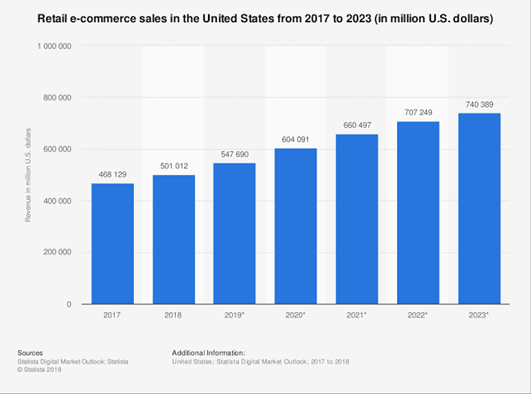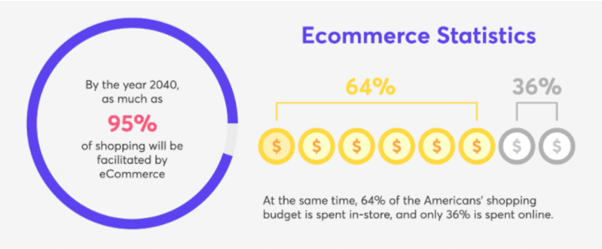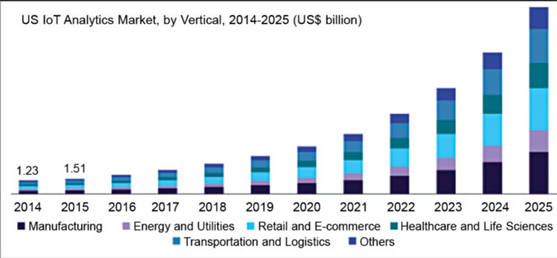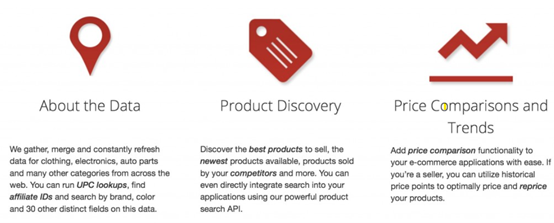Month: February 2021
Jeanne W. Ross (MIT Sloan’s Center for Information Systems Research) says-
“Clearly, the thing that’s transforming is not the technology — the technology is transforming you.”
Staying relevant has never been difficult – difficult was, to be adapted to the rapid pace of innovation, drive by the number and variety of new technologies, and most importantly, step forward with the growing economic pressures after the global pandemic. From the “big bang” to the “e-commerce boom” we have surely come a long way. But now digital transformation is probably the real buzzword for e-commerce businesses and global industry leaders.
We could start this article with a definition of digital transformation and why it’s essential for running an e-commerce business in 2021, but that would be boring (as most people aware of digital transformation and its benefits) – so we won’t. Instead, we decide to focus on the two principal aspects—
- What are the driving forces behind the digital transformation in ecommerce?
- How will digital transformation drive the future of e-commerce?
Before we dive too deep into this topic, I think it’s valid that first answer the question:
How does COVID-19 affect e-commerce businesses?
The standardized lockdown rules across the globe and the growing hesitation among consumers to go outside and shop for essential goods have tilted the nation towards e-commerce. Consumers have switched from shops, supermarkets, and shopping malls to online portals for the purchase of products, ranging from basic commodities to branded goods. Since the norm of social distancing has been initiated scope of online purchases and online businesses skyrocket. Many people have embraced the concept of online retail, and the surge in FTUs (First Time Users) on e-commerce sites is visible.

(Source: Statista.com)
As per the statista report, the market opportunities for online commerce in world are expected to touch $740 billion by 2023 from $468 billion in 2017. Based on the data available, the growth in the countries like Indian, Philippines, Malaysia are going to beat other established markets like US, Mexico, China by 2034.
On the downside of things, lack of productivity during the nationwide lockdown resulted in the loss of jobs, pay cuts, and finances. Shutting down shops and family-based businesses has made many people sway towards online retail to meet their financial requirements.
In that situation, digital transformation isn’t jargon extracted from a pretentious keynote speech, it becomes an essential part of staying in business. Now, B2B and B2C companies compete against their online rivals to take a slice of the e-commerce pie, and companies who don’t keep up quickly go bust. The above facts work as a catalyst behind the adoption of digital transformation strategies in e-commerce.
The driving force behind the digital transformation
1. Shoppers are looking for new products online
According to salesforce, 87% of shoppers look for product information and helpful reviews online — even if they plan to make their final purchases in a brick-and-mortar store. Consumers always expect to find up-to-date information and brand contact information quickly and easily.

2. Consumer expectations continue to rise
Modern consumers are now expecting to personalize experience across a range of channels. Have you heard of Omnichannel Marketing? People are enjoying apps and hope their shopping basket to travel from device to device. Hence, you need to cater to your customer base to grow your bottom line.
3. A robust online presence of brand to show value
The majority of growing brands now choose direct-to-consumer, rather than wholesale marketing strategies. The main point behind this: cut out the middleman and make more profit, and consumers get to communicate directly with brand manufacturers. Strong online presence and robust branding are the primary weapons to create a roadmap for success in that type of marketplace.
Now, you have enough reasons to implement digital transformations on the e-commerce platform. But reasons aren’t enough, you also need to know how to implement digital initiatives in your every business touchpoint. Below we describe in detail the digital trends, which will make your work much easier.
How digital transformation will shape the future trends of e-commerce.
Digital transformation does not have an endpoint, so you won’t have a chance to sit back, dust off your hands, and say, “Right— that’s it.”
Keeping up a digital vision and mindset is the most vital aspect of your organization’s digital transformation. Hence, you should keep a track of your customer expectations to modify your tactics and meet the need of your customer demographic. Instead of worrying many entrepreneurs try to approach change management with a sense of adventure and opportunity so that they can invest in new business processes and reap significant rewards. Let’s look at the principal ways of digital transformation change in e-commerce in the coming future.
1. Technology in the frontline
Only the will to achieve digital transformation is not enough. E-commerce sectors need to acquire and successfully deploy the right technology if their efforts are not to be in vain. To achieve success, e-commerce industry should improvise their IT infrastructure and software — management and maintenance skills must also be in place. Skill shortage in the IT part means rather than looking inward, B2B companies are increasingly having to explore possibilities outside the enterprise for technology provision. This puts a greater emphasis on cloud-based infrastructure and solutions, managed services, and automation.

(Source: centerity.com)
Automation is not necessarily direct AI-related technology — is a necessary step in the development and delivery of digital transformation for e-commerce at this stage. Some widely using automation processes are natural language processing (NLP), and cognitive automation, robotic process automation in conjunction with AI, and others. Here I want to highlight the top five ways to leverage automation for e-commerce business—
- Using the modern email marketing strategy, a brand can easily build automated workflows that schedule messages based on user activity or important dates. For example, the “Abandoned Cart Saver” engine works on a 100 percent automated basis.
- An online business can also automate the collection of customer feedback without any first-hand involvement.
- Inventory management is one of the tedious aspects of e-commerce that can simplify with automated accounting software- such as keeping track of purchase orders, updating the number of products in stock, or calculating the real-time valuation of your inventory.
- Automated invoicing is another essential aspect.
- Now, a business can also develop a chatbot with the help of AI without writing a single line of code.
2. Significance of big data and analytics in enhancing personalization
Big data is one of the substantial parts of e-commerce digital transformation. Giant retailers use this technology to provide consumers with highly personalize shopping experiences.
You know how they make this magic?
Online giants are using machine learning to modify site algorithms based on previous consumer activity because they recognize that familiarity boosts the bottom-line. May in the future, it will be easier for people to opt-out of personalization. But, for now, companies continue to push personalization on the Internet of Things (IoT) devices, like thermostats, doorbells, and artificial intelligence (AI) tech (think Amazon Alexa or Siri). With all these approaches, data is becoming a larger and larger component – and therefore a challenge – for many organizations.

(source: iot.electronicsforu.com)
Data analytics initiatives require a clear understanding of the objectives they’re put in place to achieve and the resources available to implement them. Stakeholder and user requirements may influence the selection of software and services. Hence, the business should choose their technology or solution partners with these considerations in mind.
3. Cloud to cater to the changing market demand
There is myriad of advantages e-commerce is drawing from cloud computing today. Most importantly, cloud in e-commerce enables the business to look big virtually and operate extensively. To make it clear, I want to highlight four crucial aspects:
- Cloud computing qualifies e-commerce applications to cater to the changing demand and scenarios of the market. It allows to upscale or downscale the online services based on demands, traffic, and seasonal spikes.
- For an e-commerce business, speed plays an important role to keep customers glued, and cloud computing provides you with greater bandwidth, computational power, and storage.
- With the cloud-native technology, strategy e-commerce can cut down the costs of developing and maintaining IT infrastructure.
- At the time of catastrophic data losses or security threats, redundancy is significant to overcome the disaster and resume business streamline. A cloud-based platform with built-in redundancy can save a business from data loss.
4. Headless and API-driven strategy continued innovation
We have a ton of favorite sites, but do we have any idea how those sites work? We hope online at free time, fulfill our midnight cravings, and go back to work. Behind the scenes – our order preferences travel faster than the speed of sound through a headless commerce system and file neatly into its database.

(Source: ecommerceinsiders.com)
In a nutshell, headless commerce decouples a company’s e-commerce platform from its frontend. When uncoupled, any data entered a website’s backend travel seamlessly to a range of frontends via application programming interfaces (APIs) — for example, progressive web apps (PWAs) and content management systems (CMSs). In order to leverage these techniques, companies add content to a compatible backend and couple on APIs – or customized frontend (like reaction button). Is it sounds too complex?
Check out few additional reasons behind use headless commerce:
Flexibility: Headless commerce is SEO friendly, and it is flexible and agile across a range of devices.
Personalization and customization: Businesses can control the consumer experience from start to finish by using a headless commerce tech stack, streaming data from one central database to a collection of APIs.
5. Content and digital web presence
Content and the creation of brand narratives can boost the processes of building a stronger digital presence while fostering brand recognition.
Content and storytelling can help reach customers and create more brand loyalty, as well as establish companies as thought leaders and experts in their field. Through a clear content program, a brand can drive product offerings with a briefing on necessary aspects and influence purchasing decisions of customers. This is an area where manufacturers and distributors need to incorporate a broader Customer Insight/experience strategy to maximize outcomes and increase revenue.
Digital web presence is often how customers experience the brand for the first time. This is also a route for improving customer experience and increase website conversion rate. According to a statistic, most consumers leave a website if it takes more than 3 seconds to load. Digital UX and UI is playing an important role to help users navigate through the website, find their requirements, and develop a trustworthy connection with the brand. Many organizations are still developing and improving the functionality of their websites and eCommerce platforms, both on the user and internal sides. Websites can drive additional growth and revenue – but they can also play a role in capturing more data, sourcing out leads, and boosting customer engagement.
6. Digital transformation at an organization level
Digital transformation is moving beyond eCommerce and marketing, to embrace the organization. It’s looking at what leadership is involved in decision making, undergoing internal process changes, and even creating new job responsibilities and titles.
New recruitment practices for digital transformation are seeking out software engineers, user experience experts, and data scientists to acquire the needed skill sets and embed the right innovation mindset across the board.
Apart from that increasing mobile shopping experience, the wide spreading of alternative payment methods, direct to consumer strategies are accelerating the digital revolution in the e-commerce industry. From understanding how buyers make decisions (and who those decision-makers are) to opportunities for more personalized content and messaging in all funnels, digital transformation technologies and data management help enable more effective e-commerce business techniques. Now, this is the time to align all business digital touchpoints with business goals, and digital strategy consulting companies are here to help you navigate through all these digital strategies. For more information and consultation feel free to reach to digital consulting service company Inovar Consulting.